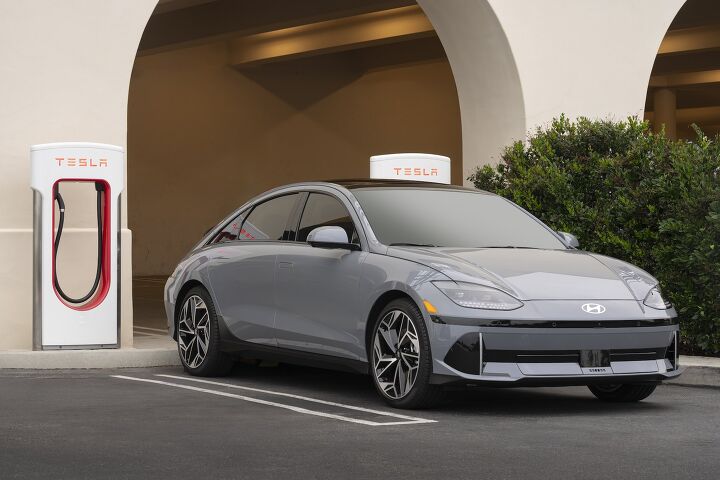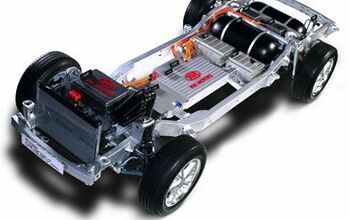Hyundai Latest to Jump on NACS Bandwagon

In what must surely be some of the least surprising automotive news you’ll read today, the corporate duo of Hyundai and Genesis have announced they will be adopting the North American Charging Standard for its EVs. This change will debut in the final quarter of next year.
As an aside, we’ll reiterate what we’ve been saying every time an automaker makes this declaration (and about all of them have, by now): This wholesale shift to NACS, which really wasn’t a “charging standard” at all in the truest sense of the word, is akin to this writer inventing a new grill on which to cook chicken in the backyard, call it a “grilling standard” and then have the likes of Weber and Traeger adopt the design. And likely pay for the privilege to do so.
It's a bit more involved than that, of course. After all, Tesla – like ‘em or lump ‘em – has built the country’s most populous and robust charging infrastructure for electric vehicles.
“Our collaboration with Tesla marks another milestone in our commitment to delivering exceptional EV experiences to our customers,” said José Muñoz, president and global COO, Hyundai Motor Company and president and CEO, Hyundai Motor North America. After typing all that out, it occurs to us that Muñoz must have one hell of a business card.
Owners of existing and future Hyundai EVs with the current CCS will have access to the Tesla Supercharging Network starting in Q1 2025. Hyundai will offer an adapter to these customers. Hyundai will also make adapters available to charge NACS-equipped vehicles at CCS chargers. This is a good thing.
Don’t forget that Hyundai is part of a multi-company group said to be developing a new, high-powered North American charging network with at least 30,000 chargers. The first American stations in this new network are targeted to open next summer. If you’re wondering, Hyundai sold nearly 35,000 of its Ioniq5 and Ioniq6 all-electrics so far this year – Kona EV numbers aren’t broken out – representing about six percent of its total YTD volume of 595,147 vehicles.
[Image: Hyundai]
Become a TTAC insider. Get the latest news, features, TTAC takes, and everything else that gets to the truth about cars first by subscribing to our newsletter.

Matthew buys, sells, fixes, & races cars. As a human index of auto & auction knowledge, he is fond of making money and offering loud opinions.
More by Matthew Guy
Latest Car Reviews
Read moreLatest Product Reviews
Read moreRecent Comments
- Tassos You can answer your own question for yourself, Tim, if you ask instead"Have Japanese (or Korean) Automakers Eaten Everyone's Lunch"?I am sure you can answer it without my help.
- Tassos WHile this IS a legitimate used car, unlike the vast majority of Tim's obsolete 30 and 40 year old pieces of junk, the price is ABSOLUTELY RIDICULOUS. It is not even a Hellcat. WHat are you paying for? The low miles? I wish it had DOUBLE the miles, which would guarantee it was regularly driven AND well maintained these 10 years, and they were easy highway miles, not damaging stop-go city miles!!!
- Tassos Silly and RIdiculous.The REAL Tassos.
- Lostboy If you can stay home when it's bad out in winter, then maybe your 3 season tire WILL be an "ALL-SEASON" tire as your just not going to get winters and make do? I guess tire rotations and alignments just because a whole lot more important!
- Mike My wife has a ‘20 Mazda3 w/the Premium Package; before that she had a ‘15 Mazda3 i GT; before THAT she had an ‘06 Mazda Tribute S V6, ie: Ford Escape with a Mazda-tuned suspension. (I’ve also had two Miata NAs, a ‘94 & a ‘97M, but that’s another story.) We’ve gotten excellent service out of them all. Her 2020, like the others before it, is our road trip car - gets 38mpg highway, it’s been from NC to Florida, Texas, Newfoundland, & many places in between. Comfortable, sporty, well-appointed, spacious, & reliable. Sure, we’d look at a Mazda hybrid, but not anytime soon.😎


































Comments
Join the conversation
The downside to this decision is that Tesla V3 chargers only go to 400 Volts, while EGMP-platform H/K/G cars cars can be charged at 800 Volts. So filling at a Supercharger today would take twice as long as Hyundai advertises.
But apparently Tesla V4 chargers will go to 800 V, so this will be better for everyone.
https://insideevs.com/news/690142/hyundai-tesla-nacs-win/
Maybe these won’t melt